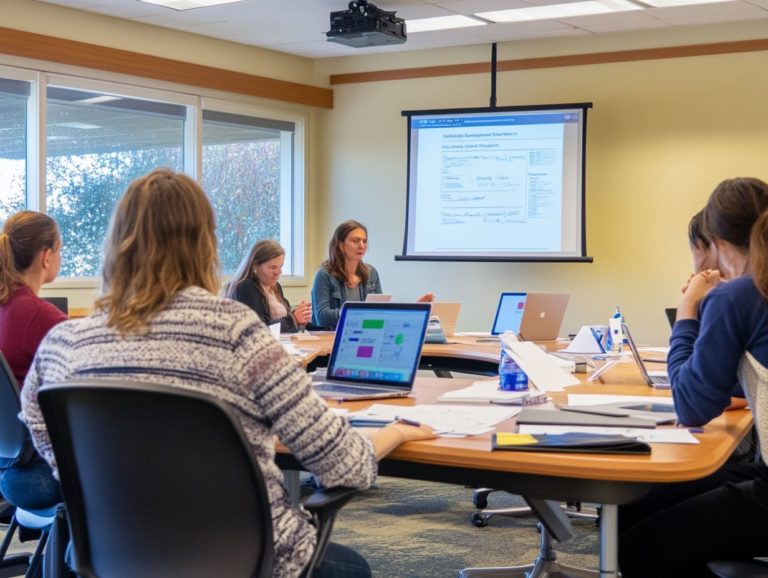How to Use Surveys to Improve Training Programs?
In today’s fast-paced world, you recognize that effective training programs are essential for fostering growth and skill development. A crucial ingredient to their success is the feedback they receive.
Understanding how participants perceive their training experience empowers you to refine your approaches and enhance outcomes.
This article delves into the vital role of feedback through various types of surveys, best practices for crafting them, and strategies to harness insights for continuous improvement. Explore how targeted feedback can elevate your training initiatives into powerful tools for success.
Contents
- Participant Satisfaction Surveys
- Post-Training Surveys
- Best Practices for Creating Effective Surveys
- Supercharge Your Training with Survey Results!
- Frequently Asked Questions
- When should surveys be given in relation to the training program?
- How should survey responses be analyzed to improve training programs?
- What are the benefits of using surveys to improve training programs?
- How can surveys be used to track the success of training programs?
Key Takeaways:

- Feedback is crucial for the success of training programs as it helps identify areas for improvement.
- Different types of surveys, such as self-assessment, satisfaction, and post-training surveys, can provide valuable insights for training program improvement.
- Creating effective surveys involves choosing the right questions, ensuring anonymity, and using the data to implement changes for better training outcomes.
Start applying these insights today to transform your training programs!
The Importance of Feedback in Training Programs
Feedback plays a crucial role in training programs, directly shaping both effectiveness and the overall learning experience for participants. By collecting feedback through various evaluations, you can assess the quality of instructor delivery, course content, and the training environment.
This process ultimately leads to improved learning outcomes and relevant enhancements to the training itself. It underscores the importance of designing user-friendly surveys that facilitate meaningful data collection, ensuring feedback is actionable and aligns with your training objectives.
Recognizing the impact of participant reactions can significantly enhance your training administration processes and foster a culture of continuous learning.
Why Feedback Matters for Training Success
Feedback is essential for the success of your training initiatives, as it offers valuable insights into how participants are reacting and helps cultivate a positive learning culture. This valuable information clarifies how participants view the training sessions and acts as a guiding compass for employee development.
By gathering input from participants, you can supercharge your training methods, ensuring they remain relevant and effective. Such feedback is instrumental in aligning training evaluations with your organization s overall goals, enabling leaders to make informed decisions that elevate overall performance.
In essence, this two-way communication fosters a culture of continuous improvement, enabling both trainers and participants to learn from one another. Ultimately, this collaborative approach drives measurable success in employee development.
Types of Surveys for Training Programs
You will encounter various types of surveys tailored for training programs, each crafted to fulfill distinct purposes that elevate the training experience and its effectiveness.
These include:
- Self-assessment surveys
- Participant satisfaction surveys
- Post-training surveys
All are designed to provide valuable insights and enhance your learning journey.
Self-Assessment Surveys
Self-assessment surveys enable you to evaluate your own learning outcomes and gauge your understanding of the course content. By encouraging you to reflect on your knowledge and skills, these surveys can significantly enhance the effectiveness of your training.
When designed thoughtfully, they can include a variety of question types from a system that measures how much you agree or disagree with a statement to open-ended inquiries that invite deeper reflection. For instance, you might assess your grasp of specific concepts or pinpoint areas where you need further development.
This process not only enables you but also generates valuable feedback for trainers, allowing them to refine course materials and delivery methods based on authentic participant experiences and insights.
Participant Satisfaction Surveys

Participant satisfaction surveys are essential tools that measure your satisfaction levels with the training course. They evaluate both the quality of the instructor s delivery and the relevance of the content.
These surveys provide important insights into how well the training aligns with your expectations and learning objectives. By collecting feedback on various aspects of your experience such as engagement, clarity, and the applicability of the material organizations can pinpoint areas that may need improvement.
The data collected often reveals trends that might not be immediately obvious. This enables targeted enhancements in instructional methods and course structure. Ultimately, this ongoing evaluation process ensures that training programs not only meet your current needs but also evolve over time, fostering a culture of continuous learning and development.
Post-Training Surveys
Post-training surveys are essential tools for evaluating how effective the training has been in terms of knowledge retention and practical application after you complete your training programs.
These surveys are important for gauging how well you have absorbed the material and how you plan to apply that knowledge in real-world situations. By gathering insights into your experiences, organizations can assess the effectiveness of the training methods used during the sessions.
The feedback you provide helps identify areas for improvement, allowing facilitators to refine content delivery and address any misunderstandings.
This approach elevates the overall quality of future training sessions, leading to more successful outcomes for both you and the organization.
Best Practices for Creating Effective Surveys
When crafting effective surveys for training programs, it s essential to pay meticulous attention to every aspect of the survey design. This includes selecting the right questions that elicit meaningful responses and ensuring that participants feel secure in keeping their responses private. Additionally, determine the optimal timing and frequency for survey deployment.
Each of these elements plays a crucial role in gathering valuable insights that drive the success of your training initiatives.
Choosing the Right Questions
Selecting the right survey questions is crucial for capturing valuable feedback from participants and evaluating the training’s impact.
Surveys can utilize various question types, each designed for a specific purpose. Closed-ended questions, with their predefined options, are important for quantifying responses and spotting trends.
For example, you can easily gauge satisfaction levels using a Likert scale, a rating system that helps measure how satisfied you feel.
On the other hand, open-ended questions invite detailed responses, allowing participants the freedom to articulate their thoughts. This qualitative data often reveals subtle nuances that closed-ended questions might miss, illuminating what participants genuinely value or where improvements are necessary.
By balancing both question types, you can gain a well-rounded understanding of the training s effectiveness and make informed adjustments as needed.
Ensuring Anonymity and Confidentiality
Keeping responses private is vital for fostering honest feedback and enhancing the quality of the data you collect.
When participants feel confident that their identities are safeguarded, they are more likely to share their true opinions. This results in data that is both reliable and insightful.
This openness is especially important when addressing sensitive topics, where individuals may fear judgment or repercussions.
To cultivate a sense of security, implement strategies such as anonymizing responses, utilizing third-party platforms, or clearly communicating your data protection measures. These practices significantly bolster participant trust.
The positive impact on training effectiveness is substantial; organizations gain valuable insights that can lead to meaningful improvements and ultimately create a more open and inclusive learning environment.
Take your surveys to the next level now!
Timing and Frequency of Surveys

The timing and frequency of surveys are crucial for maximizing the quality and relevance of the feedback you gather from training participants.
By strategically deploying surveys, you can capture insights that truly reflect immediate experiences rather than fading memories. For example, implementing short surveys right after training sessions allows participants to offer feedback while their learning remains fresh. This results in more accurate and actionable insights.
If surveys are conducted too long after the training, essential aspects of the experience might slip away from memory.
It’s also wise to consider the timing of pre-training surveys. These can help gauge baseline knowledge and expectations, creating a solid reference point for assessing the training s effectiveness. By blending these timing strategies, you can boost engagement rates, ultimately enriching the quality of the feedback you receive.
Supercharge Your Training with Survey Results!
Harnessing survey results effectively can bring about substantial enhancements in training programs. By looking at what participants say, you can implement changes rooted in data-driven insights, ensuring that your training initiatives are both relevant and impactful.
Interpreting and Analyzing Data
Interpreting and analyzing survey data is vital for understanding participant feedback and gauging the overall effectiveness of your training program.
Using a mix of quantitative and qualitative analysis techniques uncovers valuable insights hidden within the responses. Quantitative analysis uses numbers and statistics, while qualitative analysis looks at written feedback to illuminate participants emotions, perceptions, and suggestions for improvement.
This comprehensive approach highlights areas that need improvement and enables you to tailor future training sessions to meet specific participant needs. This ultimately fosters a more engaging and effective learning environment.
Implementing Changes Based on Feedback
Making changes based on participant feedback is crucial for elevating the effectiveness of your training programs.
Begin by analyzing the survey data to uncover key themes and recurring issues that attendees have highlighted. Engaging stakeholders in discussions creates a collaborative atmosphere where everyone feels valued and heard.
Next, establish clear, actionable objectives that will guide your adjustments according to the identified needs. Involving trainers in this feedback loop can significantly enhance both the delivery and content of the training.
Actively revising your training can lead to amazing improvements! This dedication not only elevates the quality of your programs but also fosters a culture of continuous improvement within your organization. Ultimately, this approach leads to more effective outcomes over the long term.
Frequently Asked Questions
How can surveys be used to improve training programs?

Surveys can gather feedback and opinions from trainees about the effectiveness of the training program, areas for improvement, and overall satisfaction with the training. For example, surveys can ask if a training module directly helped you in your job. This information can then be used to make necessary adjustments and improvements to the training program.
What types of questions should be included in a training program survey?
The survey questions should cover various aspects of the training program, such as content, delivery methods, instructor effectiveness, and overall experience. It’s important to include both open-ended and close-ended questions to gather a comprehensive understanding of trainees’ opinions.
When should surveys be given in relation to the training program?
Surveys should be given after the training program. This allows trainees to fully experience the content.
You may also send a pre-training survey to gather initial information and set expectations.
How should survey responses be analyzed to improve training programs?
Carefully analyze the responses to find common themes. This helps identify areas for improvement and trends that can inform your decisions.
What are the benefits of using surveys to improve training programs?
Surveys help tailor training programs to better fit trainees’ preferences. This means trainees are more engaged and satisfied!
How can surveys be used to track the success of training programs?
Surveys also gather feedback to measure the success of training programs. By comparing results from different times, you can evaluate how effective your changes have been.






